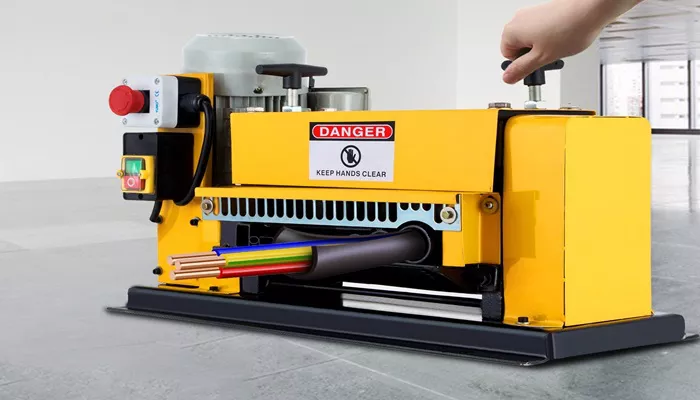Wire stripping is a fundamental process in the machinery and electrical industries. It involves removing the insulation from electrical wires to expose the conductive metal underneath, ensuring proper connections and functionality in various machines. The right tool for wire stripping plays a critical role in the precision and efficiency of this task. But what exactly is the best tool for the job? In this article, we will explore the most effective wire stripping tools, their advantages, and why choosing the right one is crucial for machinery operations.
Why Stripping Wire is Essential in the Machinery Industry?
In any machinery or electrical setup, wires play a pivotal role in transmitting power and signals. Stripping wire is necessary to ensure that the exposed metal can connect properly to terminals, plugs, or other connectors. If done improperly, the risk of poor conductivity, short circuits, or even fire hazards increases, compromising the safety and performance of machines.
The insulation on wires serves as protection from the environment, and it needs to be carefully removed without damaging the metal beneath. With machinery becoming increasingly complex and integrated, precision in wire stripping has never been more important. This is where the choice of the right tool comes into play.
The Different Types of Wire Stripping Tools
Several types of tools are designed specifically for stripping wires, each serving different needs and preferences. Let’s explore these tools and see how they align with the needs of various machinery industries.
1. Manual Wire Strippers
Manual wire strippers are hand-operated tools designed for small to medium-sized wire stripping tasks. They come in various forms, such as single-blade and double-blade designs. These tools are simple to use and can be adjusted to handle different wire gauges. Manual strippers are an excellent choice for low-volume tasks or small workshops where speed and efficiency are less critical.
2. Automatic Wire Strippers
For higher volumes of wire stripping or more complex tasks, automatic wire strippers are often preferred. These tools automatically adjust to the size of the wire, providing a consistent and accurate strip. Automatic wire strippers are faster and more efficient, reducing the risk of human error and speeding up the stripping process.
3. Knife Blades
While not as common as specialized wire strippers, knife blades can sometimes be used for stripping wire. However, this method requires a skilled hand to avoid damaging the wire. It is typically used in emergency situations or when other tools are unavailable.
4. Die-Cut Strippers
Die-cut strippers are a more specialized tool used in industrial settings. They offer precise control over the cutting process, ensuring that only the insulation is removed without nicking the conductor. These strippers are designed for high-volume production environments and can handle a wide range of wire sizes.
Why Choose Manual Over Automatic or Vice Versa?
The choice between manual and automatic wire strippers largely depends on the task at hand and the volume of work. Manual wire strippers offer precision and control but may be slow when large quantities of wires need to be stripped. On the other hand, automatic strippers increase efficiency, reduce labor, and ensure uniformity, making them ideal for industries requiring quick and large-scale wire stripping.
In machinery operations, especially in manufacturing, high-speed automation is essential. Automatic wire strippers are preferred in such contexts because of their time-saving capabilities and minimal human intervention.
Factors to Consider When Choosing a Wire Stripper
When selecting a wire stripper for machinery, several factors need to be considered:
- Wire Gauge: Ensure the stripper is suitable for the wire thickness you are working with.
- Insulation Type: Different wire insulations may require specific tools or settings to strip efficiently.
- Volume of Work: For large-scale projects, automatic or semi-automatic tools are preferred.
- Precision: For delicate machinery, the accuracy of the stripper is paramount.
- Ergonomics: Tools designed with comfort in mind reduce fatigue for the operator, especially in long working hours.
The Benefits of Choosing the Right Tool for Stripping Wire
The right wire stripping tool directly impacts the efficiency and safety of the machinery operation. Using improper tools can lead to poor wire connections, which can result in electrical failures or even machinery breakdowns. On the other hand, a high-quality wire stripper ensures that the work is done correctly, reducing maintenance costs and downtime.
Choosing the appropriate tool also contributes to the safety of the workers. Inadequately stripped wires can pose electrical hazards, while a proper wire stripper helps mitigate risks such as accidental shocks or cuts. Additionally, quality tools provide more durability and can withstand wear and tear in industrial environments.
Conclusion
The choice of the right wire stripper depends on the needs of the task at hand. Manual wire strippers are ideal for smaller operations and when precision is a priority. Automatic wire strippers are perfect for high-volume, repetitive tasks, reducing both time and error. As technology evolves, the demand for efficient and safe wire stripping tools in the machinery industry will continue to grow. Ensuring that the appropriate tool is chosen based on the requirements of the job is crucial for the longevity of both machinery and worker safety.
In summary, whether for general use or industrial operations, the correct tool for stripping wire is key to achieving success. When selecting the best tool, take into account the volume of work, wire gauge, and other operational factors. By doing so, you will increase efficiency, reduce risks, and ensure that your machinery operates optimally.

